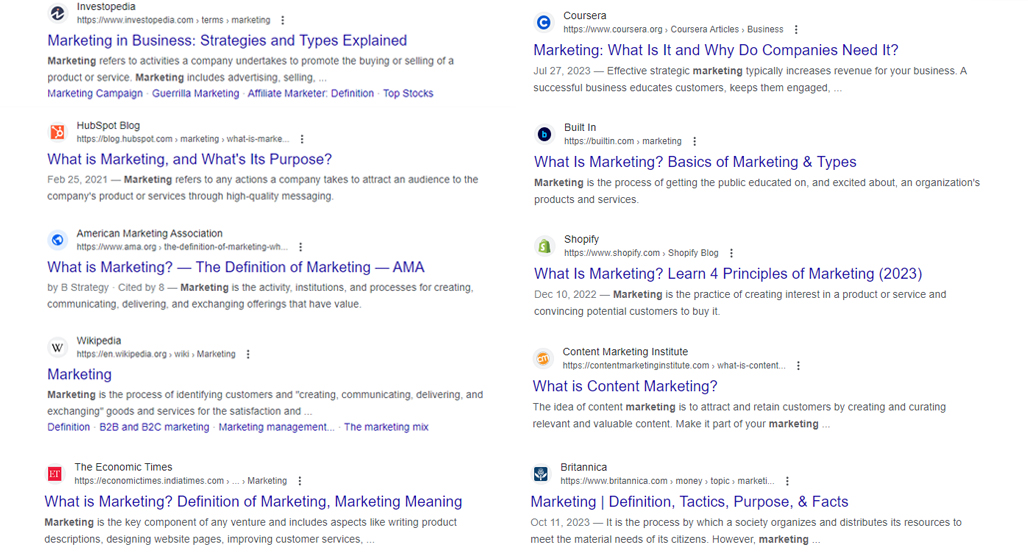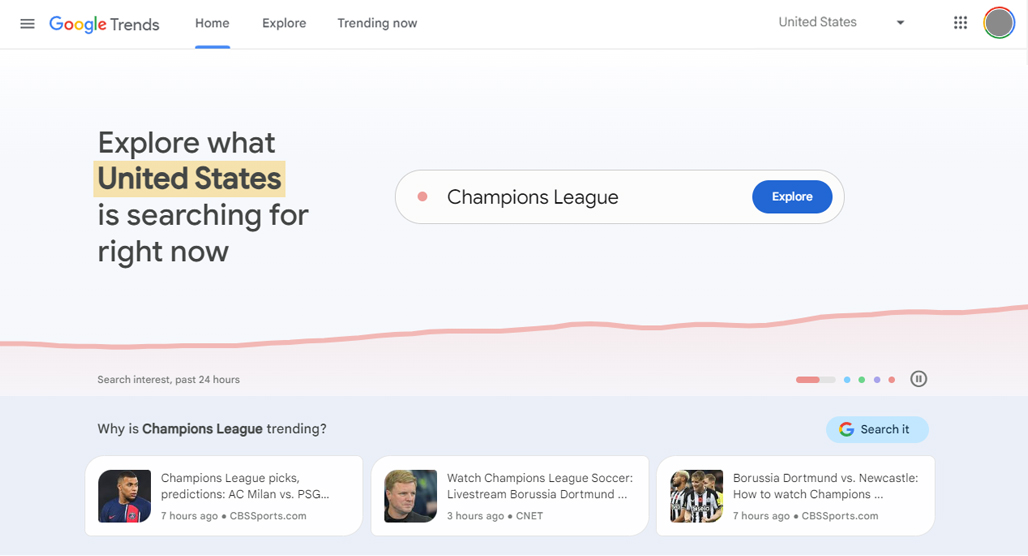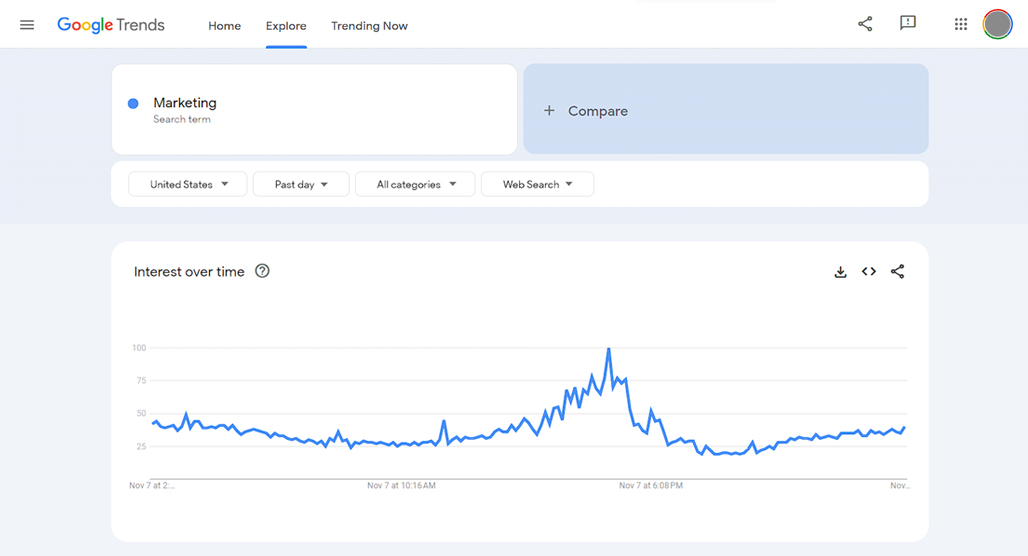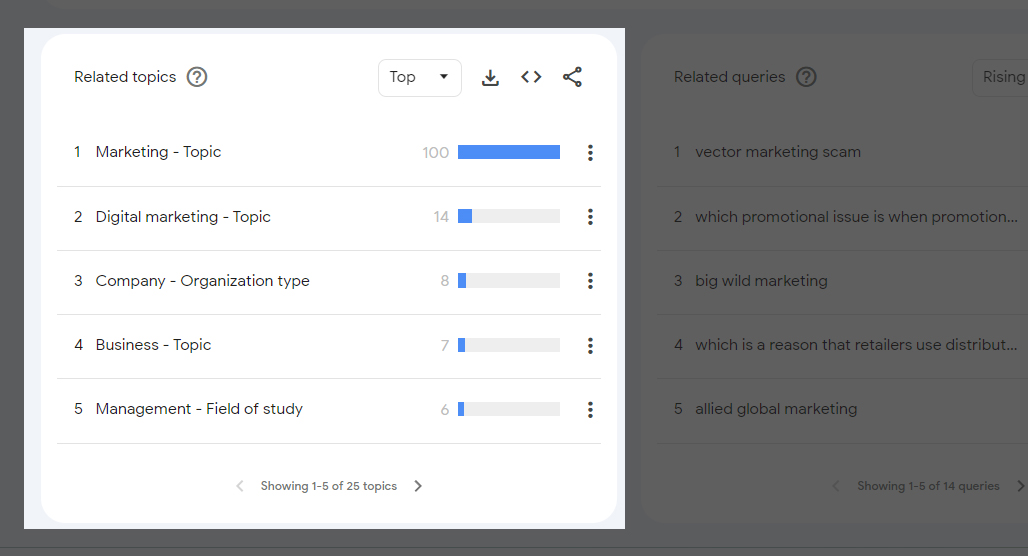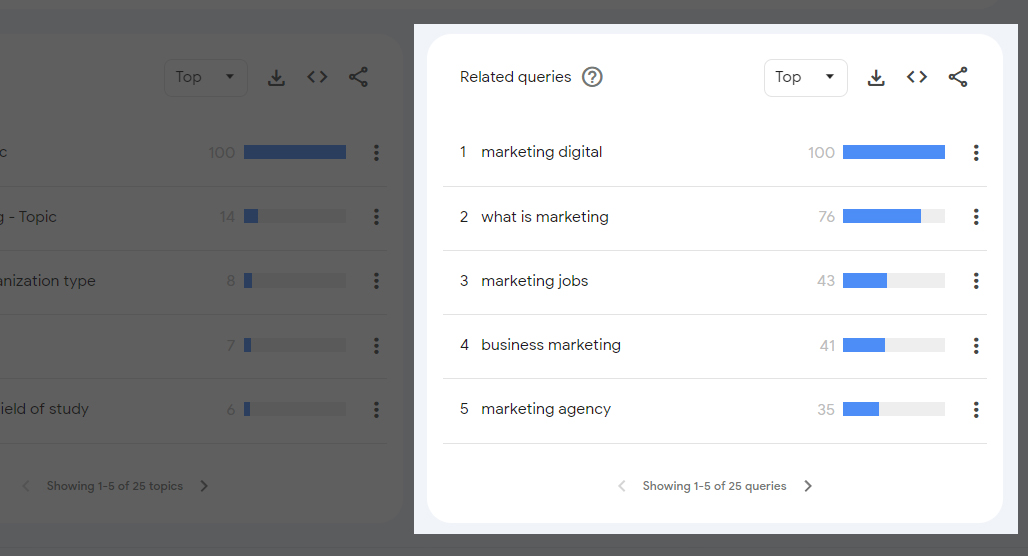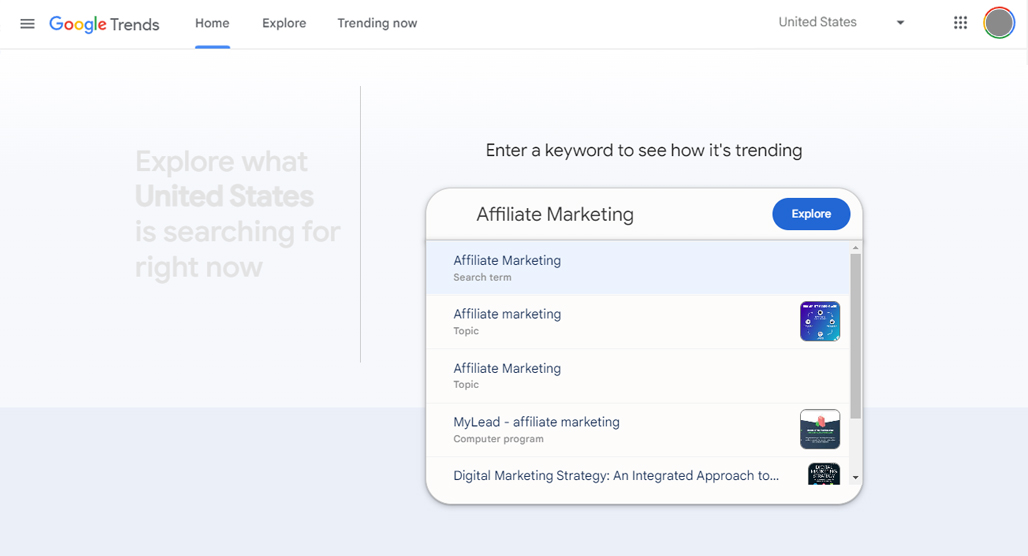How to Find the Top 100 Google Keywords in Your Industry

A huge amount of the work we marketers do in keyword research is about finding the narrow, long-tail keywords that we can rank for with a little work. These are the keywords that strike the right balance between traffic and competition. You want them to be obscure enough that they aren’t completely saturated by the big-name companies you can’t possibly hope to beat, but at the same time, if they’re too obscure and don’t get any traffic, you aren’t getting much of anything out of them. After all, anyone can rank for a keyword with 10 annual hits, but no one cares to because it simply isn’t valuable.
Sometimes, though, that’s not the goal. Sometimes, you want the broader, more valuable, top-level keywords.
Why are Top-Level Keywords Important?
Top-level keywords, the kinds of short, single-word, huge-topic keywords like “marketing,” might not seem like they’re very useful at first glance. After all, you aren’t really targeting them in individual pieces of content.
Using “marketing” as an example, just look at the top ten search results. You have Investopedia, the American Marketing Association, HubSpot, Wikipedia, the Economic Times, Coursera, Built In, Shopify, the Content Marketing Institute, and Brittanica. Looking further, the big names keep rolling in, like Optimizely, Mailchimp, Google itself, Harvard Business Review, and more.
It’s not exactly a soft query, but that’s fine. It’s also not the kind of query people are actually searching for.
So why should you look for these kinds of top-level keywords?
The core value of these keywords is as categories and as bases for further keyword digging. Each top-level keyword is a broad category of topics. It can be broken down into slightly less broad topics, which can be further broken down into narrower topics, which can further be broken down into usable topics that can guide individual pieces of content.
The process of drilling down is called keyword mapping, and the groups you end up with – related keywords branching off of larger keywords – is called keyword clustering. You can read about these topics in much greater detail here.
The individual top-level keywords you come up with can be used as blog heading categories, as tags for a tag-based organizational structure, or even just as a way of building themes into the content you produce.
So, how do you find your top-level keywords? Well, Google is the one responsible for tracking all of this information, so why not just get it directly from Google? Here’s one method I’ve used to great effect.
The Google Trends Keyword Harvesting Method
This method will get you the top 100 keywords related to any primary keyword you want to plug in. I’m still using Marketing as my example, but you can replicate it with any short-tail keyword you want.
Step 1: Visit Google Trends
The first thing you need to do is go to Google Trends.
However, you should also lay the groundwork for harvesting your data and gathering information. The easiest way to do it is with a spreadsheet – Excel or Google Sheets both work well – and maybe a little scripting to process CSV files.
Step 2: Plug in a Search Term
Google Trends looks like it has a big example animation at the top, but the search box is actually interactable. Just click on it and type in your primary keyword. In the case of Marketing, you’ll end up with a page that looks like this:
There are a bunch of parameters here, so let’s go through them.
- At the top, you have a Compare box. This allows you to compare the trends and interest in two keywords. You might use this later in the process, but for now, leave it empty.
- Country. This will default to your country, but you can change it to a different country or set it to worldwide. I recommend setting it to wherever the majority of your customers are, which might be either your country or worldwide. Usually country-level is good enough for what we’re trying to do.
- Time range. This lets you see trends within any timeframe, from the most recent hour all the way to everything since 2004. As far as your top-level keywords are concerned, this won’t really matter, but if you want to compare trend data later, it’s useful.
- Category. You can choose specific categories, like auto, beauty, and so on. If you leave it on all, you get more broad keywords; if you set it to a specific category, you narrow your possible keywords. If you find that your top-level keyword suggestions are too broad, narrow them down.
- Search type. You want web search here, unless you’re specifically looking for data for something like YouTube search.
From here, you can skip past the trending chart, though if a glance shows a steep drop in recent interest, maybe reconsider the overall topic. You can also skip past the map since we’re looking for top-level information and not local breakdowns.
Step 3: Examine the Related Keywords Box
Here’s where the real meat of our strategy comes into play: the related topics box. In the lower-left corner of the trends page, you see a list of keywords. There are two options here, and the default is “Rising,” which will be a very short list of keywords that are gaining interest. We’re not super interested in those right now, but they can be useful in other situations.
Instead, what you want to do is click the Rising box and change it to Top. This will show you the top topics/keywords related to the primary keyword you plugged in.
For Marketing, Google gives me the following:
- Marketing
- Digital Marketing
- Business
- Management
- Company
Obviously, several of these aren’t useful. But this is just the first five out of 25 that Google will give you. You can click the > to see the next five and write them all down, or you can click the button to download a CSV with all of them, which you can then process and paste into your spreadsheet. Here are the remaining 20 from my example:
- Strategy
- Affiliate Marketing
- Product
- Social Media
- Salary
- Marketing Strategy
- Advertising
- Email Marketing
- Marketing Management
- Social Media Marketing
- Digital Media
- Media
- Advertising Agency
- Brand
- Market
- Communication
- Content
- Digital
- Remote Work
- Salesforce Marketing Cloud
Again, you can see that most of these aren’t terribly useful. Some, though, are, for two reasons.
Some of these keywords work great as broad category topics for a blog. Affiliate Marketing, Social Media Marketing, Marketing Management, Email Marketing, and Digital Marketing can all be good categories to build content out of.
A couple of them are also options for other explorations you can do, repeating this whole process for another set of 25 keywords. When you repeat the process, a bunch of the topics will be similar or the same, but some will be unique, and you can keep exploring until you tap out the well.
Step 4: Harvest the Related Queries
If you want something a little more actionable and a little less top-level but still closely related to your original topic, you want to look at the box in the bottom right of the Google Trends page. This shows you the Related Queries, which are like related topics, except they’re the kinds of things real people are actually typing into Google. Some are going to be genericized or “rounded” to be more broadly representative, so you don’t get a ton of near-duplicates
This one works the same way as the related topics; you get 25 of them, and you need to click on Top instead of Rising to get the most relevant information. This is also more heavily affected by changes in geography and time in the settings from above, so make sure to set those appropriately to get the best info for your purposes.
Setting mine to USA for the past year, here’s what I get:
- Marketing
- Digital Marketing
- What is Marketing
- Marketing Jobs
- Business Marketing
- Affiliate Marketing
- Social Marketing
- Marketing Company
- Marketing Agency
- Social Media Marketing
- Marketing Manager
- Email Marketing
- Marketing Salary
- Marketing Strategy
- Product Marketing
- Marketing Online
- Google Marketing
- Marketing Companies
- Marketing Services
- Content Marketing
- Marketing Plan
- Advertising
- Marketing Definition
- Marketing Director
- Brand Marketing
Again, you can download this as a CSV to process and save, or you can handle it manually.
You’ll notice that some of these keywords overlap, and some are duplicates of the topics. That’s fine; this is all valuable information. More importantly, some of these are very useful as either top-level topics for ultimate guides, pillar content, or flagship content, or they can be the basis of entire blog categories. Affiliate Marketing and Social Marketing, we went over those above. Others, you can spin off; Marketing Companies and Marketing Services can be the root for posts about the overall industry, top-20 lists of service providers, and more, for example.
Obviously, all of these are examples for me; if you’re in a different industry, you’ll have different keyword selections.
Step 5: Harvest More
The title of this post you’re reading now is about the top 100 keywords, but Google Trends only gives you 25. How do you get the remaining 75?
If you guessed “do it three more times,” you win a cookie. Feel free to visit a website of your choice to find a pop-up that allows you to accept your reward.
Honestly, I think you’ll want to do this five or six times, maybe more, depending on how broad your overall industry is. Marketing is really wide, so all of those general category topics like Affiliate Marketing I can use as their own top-level keywords to explore queries for and get more useful keywords.
Once you have a beefy spreadsheet full of keywords, you can remove duplicates and embark on a process of qualifying the keywords, looking for specific topics to write about within each of them.
Other Ways to Get Top Keywords from Google
While Google Trends is one of the more useful ways to get keyword options to explore, there are other ways to get keyword ideas directly from Google as well.
Option 1: Look for Autocomplete Suggestions. Whenever you start typing a query into Google, they’ll offer suggestions for what you might be considering typing to save you time, make sure you’re spelling things correctly, and you’re finding what you actually want to find. Sometimes, it’s annoying and off-target, but a lot of times, it can work pretty well.
The trick to this is to type in a keyword and then a letter and see what Google comes up with. Each letter (and number) will give a selection of results, and these can easily be scraped. In fact, there are entire tools dedicated to this.
Option 2: People Also Ask. These days, when you search for something on Google, they will pop up questions based on existing content, which are drop-downs for answers. These aren’t specific keywords (for example, under Marketing, you get things like “What are the 7 keys of marketing?”), but they can be good topics to cover.
The only caveat to this option is that the questions and answers are pulled from existing content already on the web, so by definition, it’s already content you need to compete with. Sometimes, that’s a tall order.
Option 3: Skip the hassle and use Topicfinder. Topicfinder is an incredibly powerful tool that combines a variety of different methods to get you literally thousands, if not tens of thousands, of options for keywords to use. It also gives you all sorts of filters and tools to help you pre-qualify your list so you aren’t filtering out thousands of meaningless queries manually.
Give it a try! We now have a free trial, so you can give it a shot without the obligation.
As always, if you ever have any questions about anything I discuss in my articles, please feel free to let me know at any time! I’d be more than happy to answer any of your questions and assist you as best I can. Just leave me a comment down below, and I’ll be sure to get back to you as soon as I possibly can!
Leave a Comment
Fine-tuned for competitive creators
Topicfinder is designed by a content marketing agency that writes hundreds of longform articles every month and competes at the highest level. It’s tailor-built for competitive content teams, marketers, and businesses.
Get Started
